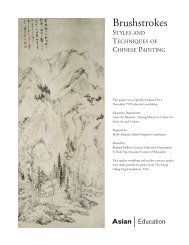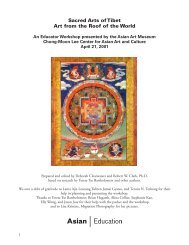Download PDF - Asian Art Museum | Education
Download PDF - Asian Art Museum | Education
Download PDF - Asian Art Museum | Education
Create successful ePaper yourself
Turn your PDF publications into a flip-book with our unique Google optimized e-Paper software.
The Edo Period (1615–1868): Some Generalizations and<br />
Assumptions<br />
Assumption: During the Edo period, Japan was isolated from foreign countries.<br />
While technically true, the reality is more complicated. The Edo government, led by the<br />
Shogun (supreme military leader) prohibited foreign interaction. (The reasons for the prohibition<br />
will be explored in the Historical Background section). Japanese were not allowed<br />
to travel out of the country, and if they did they could not return. Foreign traders and missionaries<br />
were expelled from the country. Only Dutch traders were permitted to continue<br />
business at the Japanese port of Nagasaki; the foreigners were relegated to a small artificial<br />
island called Deshima in Nagasaki Harbor. However, these regulations could not quell<br />
Japanese citizens’ curiosity with other cultures. Chinese ideas and aesthetics were widely<br />
studied and admired among literate Japanese. On average, 26 Chinese ships per year landed<br />
at Nagasaki and indirect trade with Korea continued (Schirokauer, p. 321). Western ideas<br />
came into the country via books brought by the Dutch. This gave rise to a new school of<br />
thought called Rangaku (Dutch Learning) that focused on scientific analysis of the natural<br />
world.<br />
Assumption: Edo period culture was created by the residents of the capital city of Edo<br />
(present-day Tokyo).<br />
This is only partly true. Although the city of Edo grew to prominence during the 250 years<br />
of the period, and was the locus for the development and dissemination of the woodblock<br />
prints, Edoites were very conscious of the cultural heritage of Japan’s traditional, imperial<br />
capital of Kyoto. A cultural rivalry between the two cities still exists today. The period is<br />
characterized by growth and change, often associated with the city of Edo, but it is also<br />
marked by a reverence for past traditions, represented by Kyoto. The city of Osaka, strategically<br />
located on the coast south of Kyoto, was also thriving in this period, with an aesthetically<br />
active intelligentsia. There is a saying from the Edo period that alludes to the flavor of<br />
these three great cities: An Edoite is driven to poverty by love of entertainment, a Kyotoite<br />
by love of dress, and an Osakan by love of food.<br />
Generalization: Edo period society was strictly divided into four classes: samurai,<br />
farmer, artisan, and merchant.<br />
The class system instituted by the Shogunate was meant to ensure social stability, but one of<br />
the most interesting aspects of Edo culture is that individuals were constantly finding ways<br />
around the rules. Commoners, who included farmers, artisans, and merchants, were prohibited<br />
from lavish displays of wealth, but subverted sumptuary laws that restricted the decoration<br />
of residences, means of transportation, and dress. They did this by, for example, lining<br />
their simple kimono with luxurious silks, or by following building restrictions superficially<br />
so that from the exterior their home or shop appeared to be only one story when in fact it<br />
was two. Although lowest in status, many merchants achieved great wealth during this<br />
period. Naturally, they sought to enjoy their success by collecting beautiful objects and<br />
spending money on extravagant entertainment. Occasionally, the government cracked down<br />
on excess by issuing new edicts and enforcing them more rigorously. Even samurai, who<br />
were expected to maintain high standards of conduct, felt constrained—they visited the<br />
Kabuki theater and red-light districts in disguise.<br />
<strong>Asian</strong> <strong>Art</strong> <strong>Museum</strong> <strong>Education</strong> Department
















